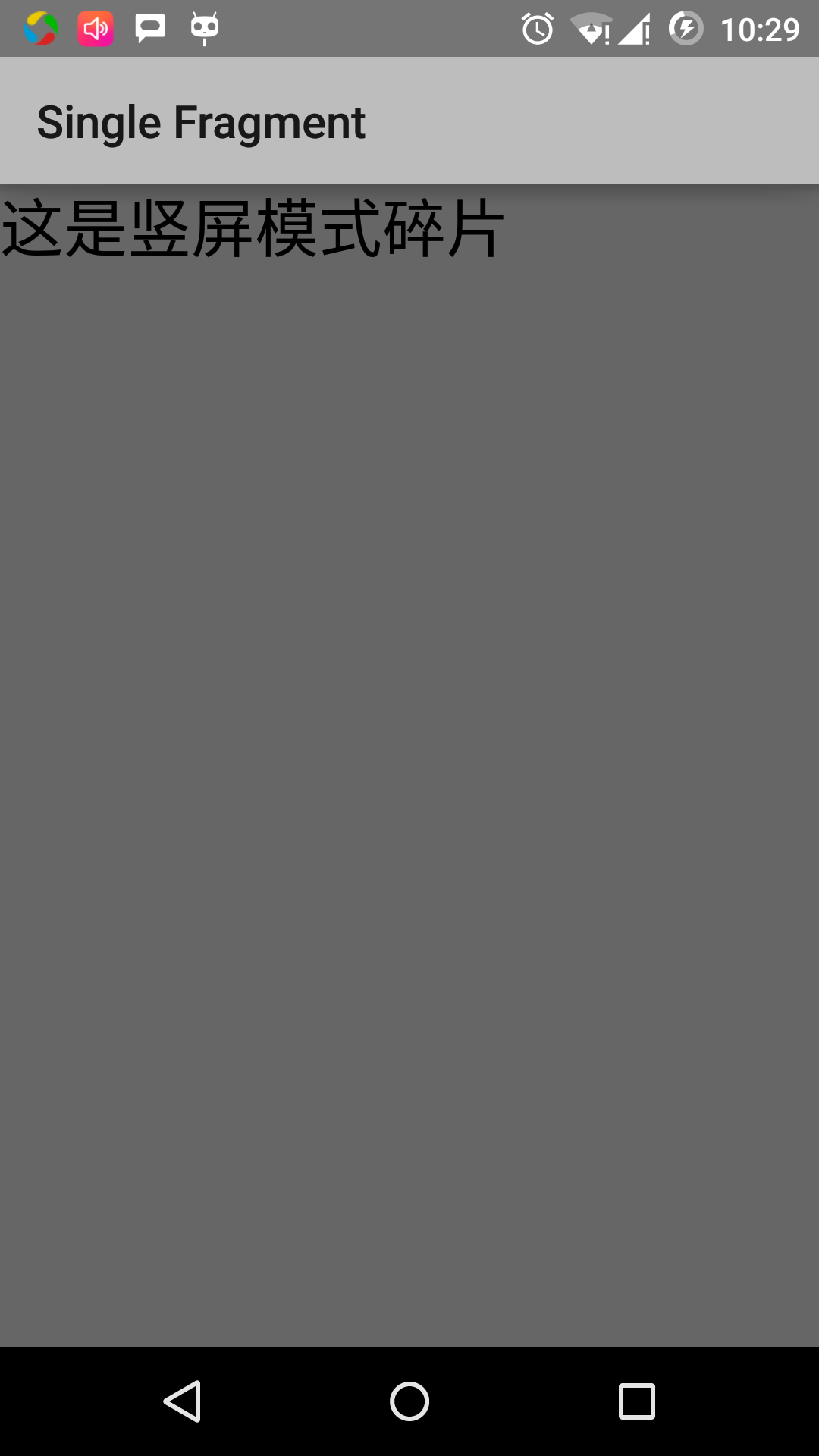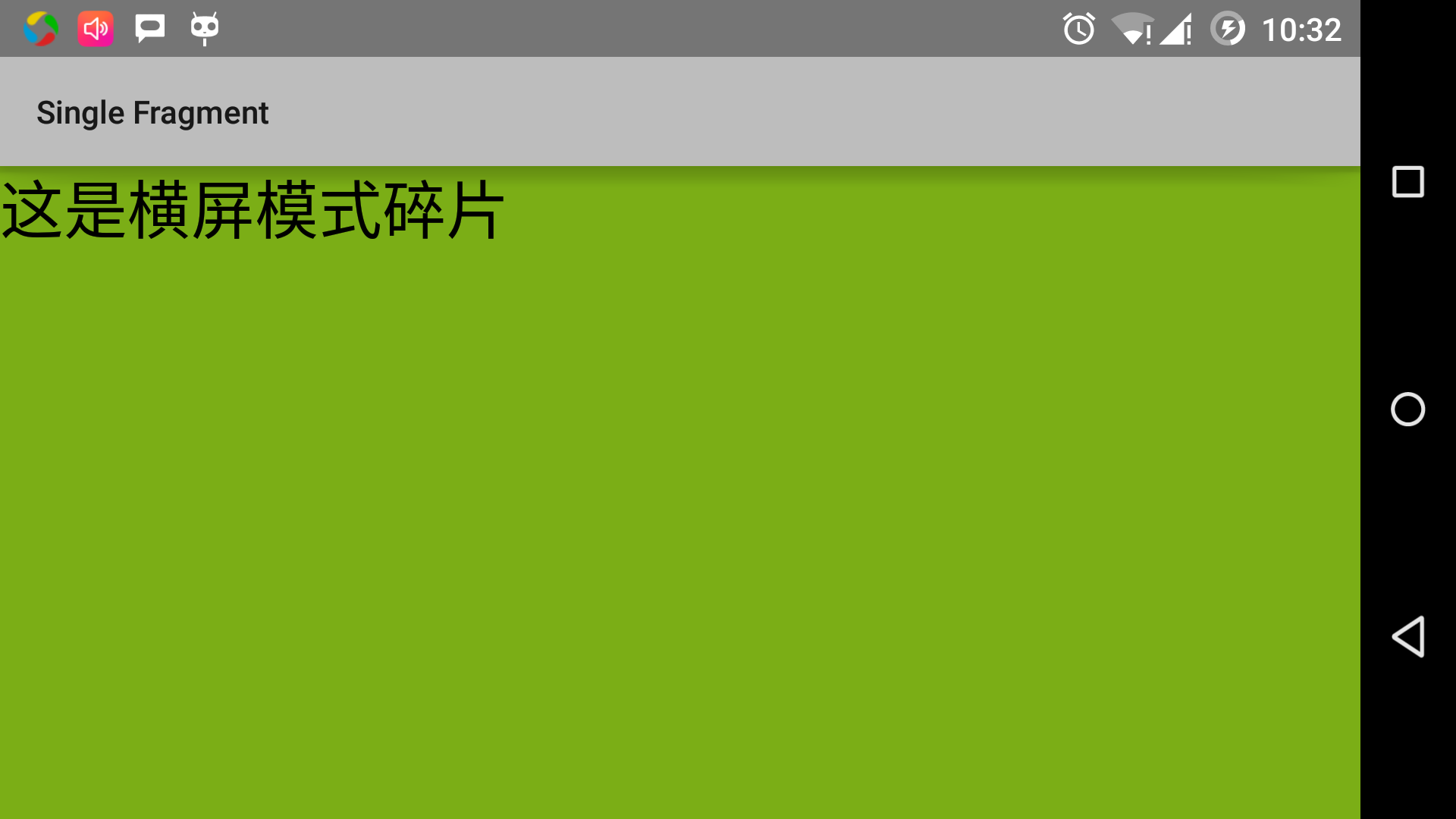Android 單幀碎片
單幀碎片:單幀碎片是為小螢幕設備所設計的,如手持設備(移動電話),Android 3.0 以上版本支持。
實例
該實例解釋如何創建自己的碎片。這裏我們創建兩個碎片,其中一個被使用在設備是橫屏的時候,另一個被使用在設備是豎屏的時候。下麵讓我們按照步驟開始吧。
| 步驟 | 描述 |
|---|---|
| 1 | 使用 Android Studio IDE 來創建一個 Android 應用程式,命名為 Single Fragments,包名 cn.uprogrammer.singlefragments。 |
| 2 | 修改如下所示的主活動檔 MainActivity.java。這裏我們將要檢查設備的方向,並基於此切換不同的碎片。 |
| 3 | 在 cn.uprogrammer.singlefragments 包下創建 PortraitFragment.java 和 LandscapeFragment.java 兩個檔,並關聯方法。 |
| 4 | 創建佈局檔 res/layout/landscape_fragment.xml 和 res/layout/portrait_fragment.xml 來定義兩個碎片的佈局。 |
| 5 | 修改 res/layout/activity_main.xml 來包含兩個碎片。 |
| 6 | 在 res/values/strings.xml 中定義需要的常量。 |
| 7 | 啟動Android模擬器來運行應用程式,並驗證應用程式所做改變的結果。 |
下麵是主要活動檔 src/cn.uprogrammer.singlefragments/MainActivity.java 的內容:
package cn.uprogrammer.singlefragment;
import android.os.Bundle;
import android.app.Activity;
import android.app.FragmentManager;
import android.app.FragmentTransaction;
import android.content.res.Configuration;
public class MainActivity extends Activity {
@Override
protected void onCreate(Bundle savedInstanceState) {
super.onCreate(savedInstanceState);
Configuration config = getResources().getConfiguration();
FragmentManager fragmentManager = getFragmentManager();
FragmentTransaction fragmentTransaction =
fragmentManager.beginTransaction();
/**
* 檢測設備方向,並做相應地操作。
*/
if (config.orientation == Configuration.ORIENTATION_LANDSCAPE) {
/**
* 設備的橫屏模式。
*/
LandscapeFragment ls_fragment = new LandscapeFragment();
fragmentTransaction.replace(android.R.id.content, ls_fragment);
}else{
/**
* 設備的豎屏模式。
*/
PortraitFragment pm_fragment = new PortraitFragment();
fragmentTransaction.replace(android.R.id.content, pm_fragment);
}
fragmentTransaction.commit();
}
}
在包 cn.uprogrammer.singlefragments 下創建兩個碎片檔 LandscapeFragment.java 和 PortraitFragment.java。
以下是 LandscapeFragment.java 檔的內容:
package cn.uprogrammer.singlefragment;
import android.app.Fragment;
import android.os.Bundle;
import android.view.LayoutInflater;
import android.view.View;
import android.view.ViewGroup;
public class LandscapeFragment extends Fragment {
@Override
public View onCreateView(LayoutInflater inflater,
ViewGroup container, Bundle savedInstanceState) {
/**
* Inflate the layout for this fragment
*/
return inflater.inflate(
R.layout.landscape_fragment, container, false);
}
}
以下是 PortraitFragment.java 檔的內容:
package cn.uprogrammer.singlefragment;
import android.app.Fragment;
import android.os.Bundle;
import android.view.LayoutInflater;
import android.view.View;
import android.view.ViewGroup;
public class PortraitFragment extends Fragment {
@Override
public View onCreateView(LayoutInflater inflater,
ViewGroup container, Bundle savedInstanceState) {
/**
* Inflate the layout for this fragment
*/
return inflater.inflate(
R.layout.portrait_fragment, container, false);
}
}
在目錄 res/layout 目錄下創建2個佈局檔 landscape_fragment.xml 和 portrait_fragment.xml。
以下是 landscape_fragment.xml 檔的內容:
<?xml version="1.0" encoding="utf-8"?>
<LinearLayout
xmlns:android="http://schemas.android.com/apk/res/android"
android:orientation="vertical"
android:layout_width="fill_parent"
android:layout_height="fill_parent"
android:background="#7bae16">
<TextView
android:layout_width="fill_parent"
android:layout_height="wrap_content"
android:text="@string/landscape_message"
android:textColor="#000000"
android:textSize="28sp" />
<!-- More GUI components go here -->
</LinearLayout>
以下是 portrait_fragment.xml 檔的內容:
<?xml version="1.0" encoding="utf-8"?>
<LinearLayout
xmlns:android="http://schemas.android.com/apk/res/android"
android:orientation="horizontal"
android:layout_width="fill_parent"
android:layout_height="fill_parent"
android:background="#666666">
<TextView
android:layout_width="fill_parent"
android:layout_height="wrap_content"
android:text="@string/portrait_message"
android:textColor="#000000"
android:textSize="28sp" />
<!-- More GUI components go here -->
</LinearLayout>
以下是 res/layout/activity_main.xml 檔的內容,其中包含兩個碎片:
<?xml version="1.0" encoding="utf-8"?>
<LinearLayout xmlns:android="http://schemas.android.com/apk/res/android"
xmlns:tools="http://schemas.android.com/tools"
android:layout_width="fill_parent"
android:layout_height="fill_parent"
android:orientation="horizontal">
<fragment
android:id="@+id/landscape_fragment"
android:layout_weight="1"
android:layout_width="0dp"
android:layout_height="match_parent" />
<fragment
android:id="@+id/portrait_fragment"
android:layout_weight="2"
android:layout_width="0dp"
android:layout_height="match_parent" />
</LinearLayout>
確保 res/values/strings.xml 檔包含如下內容:
<?xml version="1.0" encoding="utf-8"?>
<resources>
<string name="app_name">Single Fragment</string>
<string name="hello_world">Hello world!</string>
<string name="action_settings">Settings</string>
<string name="landscape_message">這是橫屏模式碎片</string>
<string name="portrait_message">這是豎屏模式碎片</string>
</resources>
讓我們運行剛剛修改的 Single Fragments 應用程式。我假設你已經在安裝環境時創建了 AVD。打開你的專案中的活動檔,點擊工具欄中的 圖示來在 Android Studio 中運行應用程式。Android Studio 在 AVD 上安裝應用程式並啟動它。如果一切順利,將在模擬器窗口上顯示如下:
圖示來在 Android Studio 中運行應用程式。Android Studio 在 AVD 上安裝應用程式並啟動它。如果一切順利,將在模擬器窗口上顯示如下:

按照下列操作來改變模擬器螢幕的方向模式:
- fn+control+F11 在mac上改變橫屏為豎屏,反之亦然
- ctrl+F11 在windows上
- ctrl+F11 在Linux上
當你修改模式,你將看到適用於橫屏模式的頁面實現:

通過這種方法,你可以在同一個活動中通過使用不用的碎片來實現不同的介面。可以按照你的需求使用不同類型的介面組件來構建介面。
